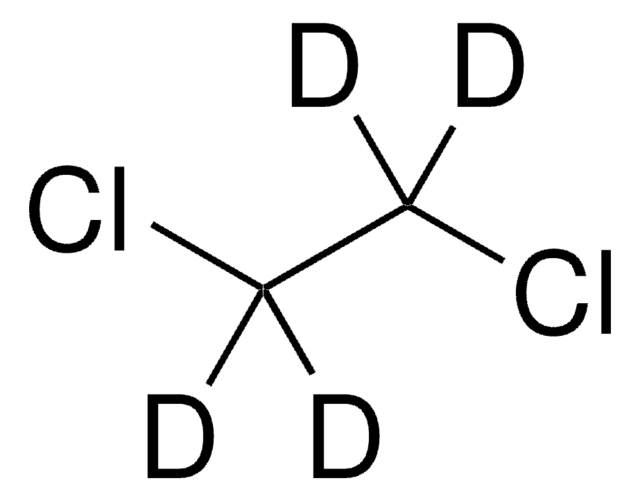319929
1,2-Dichloroethane
ACS reagent, ≥99.0%
Synonym(s):
Ethylene chloride, Ethylene dichloride
About This Item
Recommended Products
grade
ACS reagent
Quality Level
vapor density
3.4 (20 °C, vs air)
vapor pressure
87 mmHg ( 25 °C)
Assay
≥99.0%
form
liquid
autoignition temp.
775 °F
expl. lim.
15.6 %
impurities
≤0.0003 meq/g Titr. acid
≤0.03% water
evapn. residue
≤0.002%
color
APHA: ≤10
clear
refractive index
n20/D 1.444 (lit.)
bp
83 °C (lit.)
mp
−35 °C (lit.)
density
1.256 g/mL at 25 °C (lit.)
SMILES string
ClCCCl
InChI
1S/C2H4Cl2/c3-1-2-4/h1-2H2
InChI key
WSLDOOZREJYCGB-UHFFFAOYSA-N
Looking for similar products? Visit Product Comparison Guide
General description
Application
- As electron acceptor in the culture medium of Dehalococcoides ethenogenes 195.
- As model compound for chlorinated organics in various studies.
- Chemical doping during the fabrication of Cl-doped few-layer WS2 or MoS2 back gate field-effect transistors (FETs).
Signal Word
Danger
Hazard Statements
Precautionary Statements
Hazard Classifications
Acute Tox. 3 Inhalation - Acute Tox. 4 Oral - Asp. Tox. 1 - Carc. 1B - Eye Irrit. 2 - Flam. Liq. 2 - Skin Irrit. 2 - STOT SE 3
Target Organs
Respiratory system
Storage Class Code
3 - Flammable liquids
WGK
WGK 3
Flash Point(F)
55.4 °F - closed cup
Flash Point(C)
13 °C - closed cup
Choose from one of the most recent versions:
Already Own This Product?
Find documentation for the products that you have recently purchased in the Document Library.
Our team of scientists has experience in all areas of research including Life Science, Material Science, Chemical Synthesis, Chromatography, Analytical and many others.
Contact Technical Service









